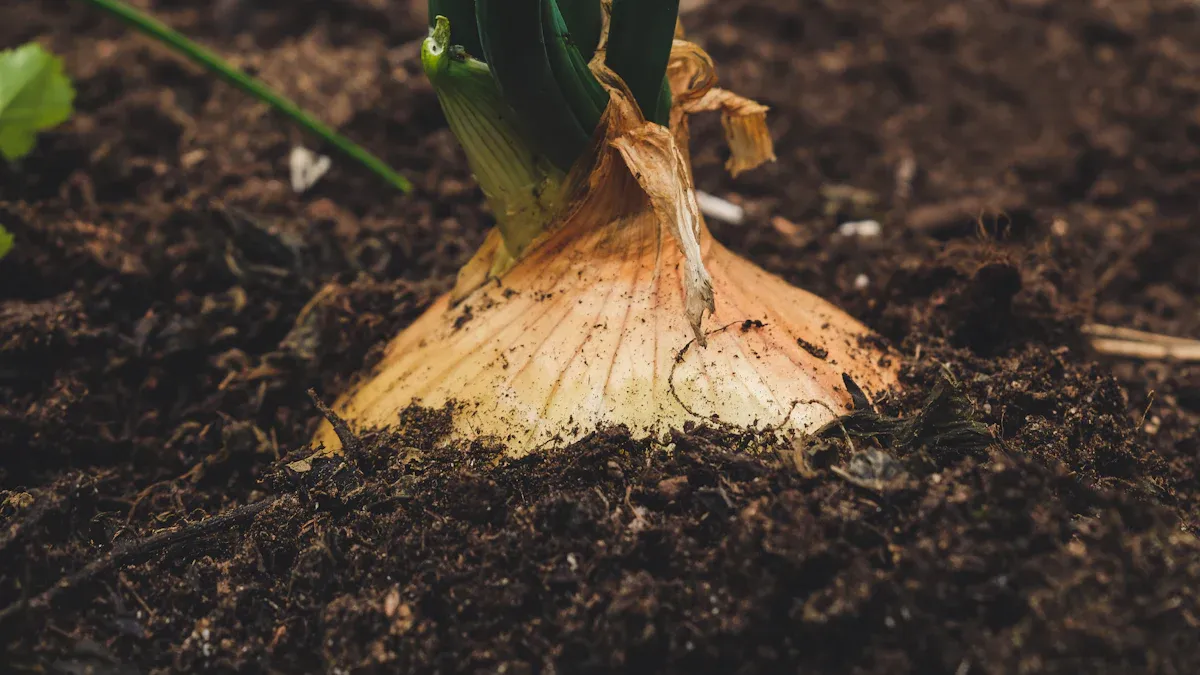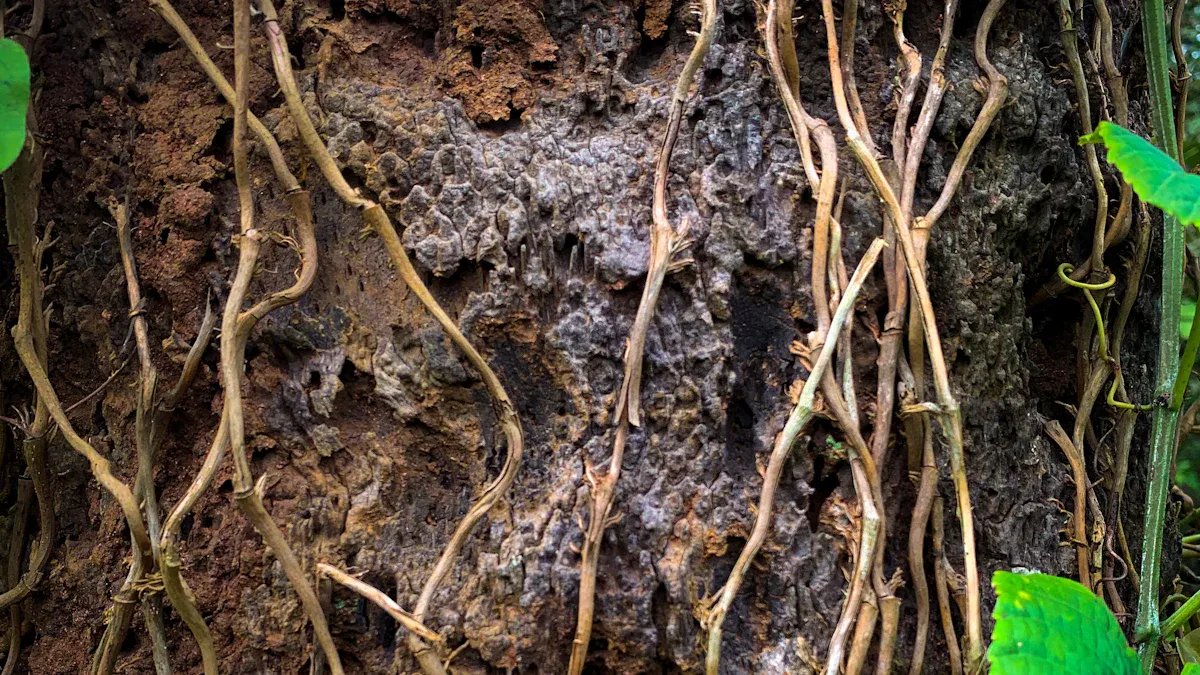
Soil health is crucial for thriving ecosystems and productive agriculture. Did you know that more than 95 percent of terrestrial plant species form symbiotic relationships with mycorrhizae in soil health? These tiny organisms play a key role in enhancing nutrient absorption and improving soil structure. By partnering with plants, mycorrhizae in soil health help them access vital nutrients and water. This relationship supports not only plant growth but also overall soil health.
Key Takeaways
Mycorrhizae, especially arbuscular mycorrhizal fungi (AMF), enhance nutrient uptake, allowing plants to absorb up to 90% of their phosphorus from the soil.
These fungi improve soil structure by creating networks that bind soil particles, which enhances stability and reduces erosion.
Fostering mycorrhizal networks boosts plant health by increasing resistance to diseases and environmental stresses.
To promote mycorrhizal development, reduce soil disturbance with no-till practices and plant a diverse range of species.
Minimize the use of chemical fertilizers to protect mycorrhizal fungi and support a healthy soil ecosystem.
Mycorrhizae in Soil Health

Types of Mycorrhizae
Mycorrhizae come in two main types: ectomycorrhizae and endomycorrhizae. Each type plays a unique role in supporting plant health.
Ectomycorrhizae:
These fungi form a sheath around the roots of many evergreen trees and shrubs.
They cover the ends of young roots, enhancing nutrient absorption.
Endomycorrhizae:
These fungi invade the plant’s roots and develop entirely within the plant.
They include several subtypes, such as arbuscular mycorrhizal fungi (AM), which penetrate root cells and form structures called arbuscules.
Here’s a quick overview of the main types and their subtypes:
Main Type | Subtypes |
|---|---|
Ectomycorrhizae | – Sheathing mycorrhizae |
– Common on woody plants (e.g., conifers) | |
Endomycorrhizae | – Arbuscular mycorrhizae |
– Vesicular-arbuscular mycorrhizae | |
– Ericoid mycorrhizae | |
– Orchid mycorrhizae | |
– Monotropoid mycorrhizae | |
– Ectoendomycorrhizae (transitional) |
Symbiotic Relationships
Mycorrhizae form beneficial partnerships with plants. These relationships allow plants to absorb nutrients and water more efficiently. The fungal hyphae extend beyond the plant’s root zone, increasing the effective surface area for nutrient uptake. This means you can expect better access to essential micronutrients and macronutrients.
Mycorrhizal fungi act as extensions of the plant’s root system. They absorb nutrients along their entire length, improving nutrient exchange.
In return, plant roots provide a hospitable environment for fungi. This mutualistic relationship has existed for about 400 million years and is found in approximately 90% of land plants.
By fostering these mycorrhizal networks, you can enhance plant vigor, drought resistance, and overall soil health. Understanding these relationships is crucial for anyone interested in gardening or sustainable agriculture.
Mycorrhizae Benefits

Enhancing Soil Fertility
Mycorrhizae play a vital role in enhancing soil fertility. These fungi improve nutrient acquisition, especially phosphorus, which is crucial for plant growth. Approximately 75% of land plant species form relationships with arbuscular mycorrhizal fungi (AMF). This partnership allows plants to access nutrients that are often locked away in the soil.
AMF produce organic acids and enzymes that help break down soil minerals, making phosphorus more available to plants.
Studies show that conservation tillage practices increase the diversity and abundance of AMF, leading to improved plant growth (Qin et al., 2017; Gu et al., 2020).
Crop rotation can also boost AMF populations, enhancing yields in subsequent crops. For example, rotating maize with legumes like soybean or chickpea increases AMF spore density, positively affecting wheat yields (Higo et al., 2013; Bakhshandeh et al., 2017).
The presence of mycorrhizal fungi can reduce the need for chemical fertilizers. Research indicates that AMF inoculation allows for lower fertilizer inputs while maintaining crop yields, particularly in low-fertility soils. This not only saves costs but also promotes sustainable farming practices.
Improving Soil Structure
Mycorrhizae significantly improve soil structure. They create networks of hyphae that bind soil particles together, enhancing aggregation. This process leads to better soil porosity and water retention.
Mycorrhizal fungi produce a substance called glomalin, which helps stabilize soil aggregates. This stabilization is crucial for maintaining healthy soil structure (Rillig, 2004).
The hyphal networks formed by AMF improve water infiltration rates. They can access deep water through micro-pores and cracks in the soil, ensuring that plants receive adequate moisture even during dry periods.
Studies have shown that mycorrhizal fungi enhance soil aggregate stability, although the effects may vary based on environmental conditions (Tisdall & Oades, 1982).
In addition to improving soil structure, mycorrhizae also contribute to pest and disease resistance. They enhance the permeability of plant root cell membranes, which can affect root exudates and rhizosphere properties. This interaction helps plants fend off soil-borne pests and diseases. Mycorrhizae can even paralyze nematodes and repel pathogens, reducing root invasion. By promoting beneficial soil microorganisms, they increase plant resistance to diseases.
Nutrient Cycling and Mycorrhizae
Nutrient Uptake
Mycorrhizal fungi play a crucial role in enhancing nutrient uptake for plants. They form extensive networks of hyphae that extend far beyond the root zone. This allows plants to access nutrients that would otherwise remain unavailable. Here are some key points about how mycorrhizae improve nutrient cycling:
Mycorrhizal fungi can provide up to 90% of phosphorus to host plants, especially in soils with low phosphorus levels.
They acquire and immobilize nitrogen and phosphorus in their hyphae, reducing nutrient losses through leaching and denitrification.
These fungi facilitate nutrient transfer between plants through their hyphal networks. This is particularly beneficial in intercropping systems, where different plants can share nutrients effectively.
Inoculating plants with arbuscular mycorrhizal fungi (AMF) enhances nutrient uptake efficiency and reduces the need for fertilizers, especially in nutrient-limited conditions.
The following table summarizes the measured increase in nutrient uptake associated with mycorrhizal fungi:
Nutrient Type | AMF+ Plants (kg/ha) | AMF− Plants (kg/ha) |
|---|---|---|
Phosphorus | 12.59 | N/A |
Aerial Biomass P Uptake | 3.05 (mean) | 3.32 (mean) |
Seed Nitrogen Uptake | 4.40% higher | N/A |
Research shows a strong positive correlation between total plant phosphorus uptake and seed yield. This indicates that mycorrhizal fungi significantly contribute to plant growth and productivity.
Microbial Biodiversity
Mycorrhizal fungi also influence the diversity and abundance of soil microbial communities. They create a more resilient ecosystem by enhancing interactions among various soil organisms. Here are some important aspects of this relationship:
Mycorrhizal fungi stimulate the development of microbial communities by increasing microbial biomass carbon and nutrient absorption.
They create protective niches for bacteria and provide organic-rich exudates that serve as substrates, enhancing cooperative interactions.
The presence of mycorrhizal fungi improves nutrient cycling efficiency, plant growth, and stress resilience.
The following table highlights how mycorrhizal relationships impact microbial diversity:
Evidence | Description |
|---|---|
EM-dominated stands | Characterized by decreased prokaryotic diversity compared to mixed AM-EM forests. |
Microbial community differences | Driven by plant community differences or microbiome assembly, affecting ecosystem functions. |
Soil microbiome impact | EM relationships influence plant health and ecosystem function through changes in microbial community composition. |
By fostering mycorrhizal networks, you not only enhance nutrient uptake but also promote a diverse and thriving microbial community. This diversity is essential for maintaining soil health and resilience.
Environmental Impact of Mycorrhizae
Erosion Control
Mycorrhizae play a significant role in controlling soil erosion. They help stabilize soil aggregates, which reduces the risk of erosion caused by wind and water. Here are some key points about how mycorrhizal fungi contribute to erosion control:
Mycorrhizal fungi enhance soil organic matter, which improves soil structure.
They create networks of hyphae that bind soil particles together, increasing aggregate stability.
Research shows that different treatments affect soil erosion rates. For example, oat straw mulching leads to zero soil erosion, while herbicide application results in a higher erosion rate of 0.97 Mg/ha/h.
Treatment Type | Soil Organic Matter (%) | Mycorrhizal Proteins (mg/g soil) | Aggregate Stability (%) | Soil Erosion Rate (Mg/ha/h) |
|---|---|---|---|---|
Oat Straw Mulching | 4.5 | 1350 | 80 | 0 |
Herbicide Application | 2 | 700 | 41 | 0.97 |
Ploughing | 2 | 400 | 57 | 0.01 |
Water Retention
Mycorrhizae also improve soil water retention, which is crucial for plant health. They influence the soil’s hydraulic properties through various mechanisms. Here’s how mycorrhizal fungi enhance water retention:
The hyphal networks created by mycorrhizal fungi increase soil porosity, allowing more water to be held in the soil.
In less compacted soils, these networks improve capillarity, helping retain water even after drainage.
Studies indicate that the presence of mycorrhizal fungi correlates positively with soil water-retention capacity.
“Mycorrhizal fungi play a subtle but important role in shaping the hydraulic properties of soils through multiple direct and indirect mechanisms related to mycorrhizal-induced changes in soil structure and organic matter content.”
By fostering mycorrhizal networks, you can significantly enhance both erosion control and water retention in your soil. This not only supports plant growth but also contributes to overall soil health.
Mycorrhizae play a vital role in enhancing soil health and promoting sustainable practices. Here are some key takeaways:
Mycorrhizae, especially arbuscular mycorrhizal fungi (AMF), improve nutrient uptake, allowing plants to absorb up to 80% of their phosphorus from the soil.
They contribute to soil stability by creating sticky aggregates, enhancing organic matter and preventing erosion.
Fostering mycorrhizal networks can lead to greater resistance against pathogens and abiotic stresses, boosting plant health.
To encourage mycorrhizal development in your soil, consider these practical steps:
Reduce soil disturbance by adopting no-till practices.
Plant a diverse range of species to support various mycorrhizal communities.
Avoid overusing fertilizers and chemicals to protect mycorrhizal fungi.
By implementing these strategies, you can significantly enhance soil health and productivity in your gardening or farming efforts.
FAQ
What are mycorrhizae?
Mycorrhizae are beneficial fungi that form networks with plant roots. They enhance nutrient absorption and improve soil health. These networks allow plants to access water and nutrients more efficiently.
How do mycorrhizae benefit plants?
Mycorrhizae improve plants’ nutrient uptake, especially phosphorus. They create extensive networks that connect plants to soil nutrients, promoting growth and resilience against stressors like drought.
Can I encourage mycorrhizal networks in my garden?
Yes! You can encourage mycorrhizal networks by reducing soil disturbance, planting diverse species, and minimizing chemical fertilizers. These practices support healthy soil ecosystems.
How do mycorrhizae affect soil structure?
Mycorrhizae enhance soil structure by forming networks that bind soil particles together. This improves soil aggregation, porosity, and water retention, leading to healthier soil.
Are mycorrhizal networks important for sustainable agriculture?
Absolutely! Mycorrhizal networks play a crucial role in sustainable agriculture. They reduce the need for chemical fertilizers, improve soil health, and enhance crop yields.
